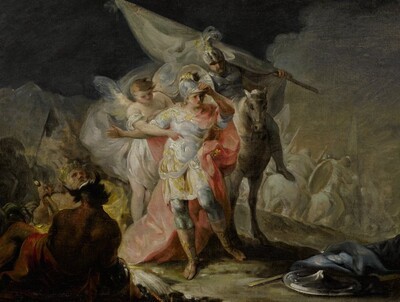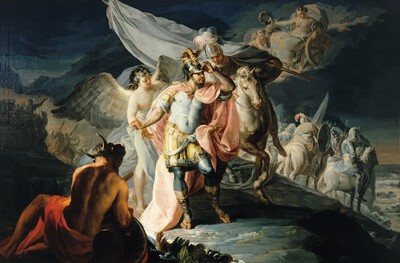- Cronología
- Ca. 1770 - 1771
- Ubicación
- Museum of Zaragoza, Zaragoza, Spain
- Dimensiones
- 30.6 x 38.5 cm
- Técnica y soporte
- Oil on canvas
- Reconocimiento de la autoría de Goya
- Documented work
- Titular
- Government of Aragon
- Ficha: realización/revisión
- 14 Feb 2010 / 11 Dec 2024
- Inventario
- (51356)
- Otros títulos:
-
Hannibal Crossing the Alps (Aníbal cruzando los Alpes)
This work is a sketch for the painting entered by Goya into the competition of the Academy of Fine Arts of Parma announced in 1770. It was published by José Manuel Arnaiz and Rogelio Buendía in 1984. At the time it was received with some reservations, given its poor state of conservation following the restoration work it underwent prior to publication. The drawings and notes in the Italian Sketchbook confirm its authenticity, since Goya dedicated no less than four pages of his notebook to preparatory studies for this sketch. Arnaiz and Buendía published a detail showing Goya's signature on the sketch.
The work belonged to a private collection in Zaragoza before it was sold on to the collection of Garmendia-Herrero, in Villafranca de Ordicia. In 1984 it entered a private collection in Madrid, where it remained until 1991 when it was entrusted to the Museum of Zaragoza by José María González García. The same year it was acquired by the Government of Aragón, but continued to be housed in the Museum of Zaragoza.
From December 5th, 2024, and while the Zaragoza Museum remains closed for works, the painting is part of the exhibition 'Goya. From the Museum to the Palace' in the Aljafería Palace in Zaragoza.
The subject of the work is Hannibal, the Carthaginian general, crossing the Alps and taking in his first view of Italy. There are some differences between this sketch and the definitive work. It seems that Goya had decided to place Hannibal in the centre of the composition early on, since this does not change either in this sketch or in the other surviving study, or indeed in the notes of the Italian Sketchbook, although in the latter we can observe a change of orientation in the composition, which is vertical. The dimensions of canvasses to be entered into the competition were specified by the academy, which is surely what led Goya to change the orientation.
The pose of the Carthaginian general is the same, in line with the competition rules. His position appears to have been inspired by the Apollo Belvedere, although here he displays a more pronounced contrapposto. Behind Hannibal, there is a soldier on horseback carrying a standard and a shield which is placed behind the general's head as if it were a halo, a feature which would not appear in the final painting. In the background, the rest of the soldiers descend towards the valley. In the foreground, we can see the allegorical figure representing the River Po, and opposite her, a new figure with blond hair. Given the sparse details of the sketch, it is not quite clear who this figure is. Arnaiz and Buendía believe that the figure is a boy, while Wilson interprets it as being a vanquished barbarian who gazes up at the hero Hannibal. Manuel Mena identifies it as an allegorical representation of the Alps, taking the second, more detailed sketch into account.
The colour scheme of this study is much more vivid than that used in the final work, which acquired a more unreal, atmospheric feel due to the coolness of the tones employed.
The 1993 restoration revealed the virtuoso technique used by Goya for this work, although the impasto brushwork lost its physical relief forever.
For more information on the Parma competition, see Hannibal the Conqueror, Viewing Italy for the First Time from the Alps.
The painting was lined some time before 1984, leaving the painted surface flattened and making the thick line of the canvas more visible. It was also overpainted.
In 1993 the painting underwent further restoration work. It was attached to a new frame and it was enlarged at the edges, adding 1 cm strips on the upper part of the canvas, 2 cm on the right-hand side, and 1.5 cm at the bottom of the canvas, which are now hidden by the current frame, restoring the visual effect of the original format.
-
Goya joven (1746-1776) y su entornoMuseo e Instituto Camón AznarZaragoza1986consultant editorl José Rogelio Buendía. November 21st to December 20th 1986cat. 17
-
Los pintores de la IlustraciónCentro Cultural Conde DuqueMadrid1988consultant editors José Manuel Arnaiz and José Luis Morales y Maríncat. 52
-
Los pintores en tiempos de Carlos IIISala capitular del Ayuntamiento de ÉcijaÉcija1988from December 16th 1988 to January 6th 1989cat. 21
-
Goya (1746 – 1828)Galleria Internazionale d’Arte Moderna di Ca’PesaroVenecia1989consultant editor Antonio Fortún Paesa. From May 7th to July 4th 1989cat. 3
-
GoyaLa Lonja, Torreón Fortea y Museo Pablo GargalloZaragoza1992consultant editor Julián Gállegocat. 2
-
Goya. El Capricho y la Invención. Cuadros de gabinete, bocetos y miniaturasMuseo Nacional del PradoMadrid1993from November 18th 1993 to February 15th 1994. Exhibited also at the Royal Academy of Arts, London, March 18th to June 12th 1994 and The Art Institute of Chicago, Chicago, July 16th to October 16th 1994, consultant editors Manuela B. Mena Marqués and Juliet Wilson-Bareaucat. 1
-
Goya en las colecciones españolasSala de Exposiciones del BBVAMadrid1995consultant editor Juan J. Luna. From December 14th 1995 to February 17th 1996cat. 2
-
Hannibal, vainqueur, contemplant l’Italie depuis les Alpes de Francisco de GoyaChâteaux de MalbrouckManderen (Lorena)2002
-
Goya e ItaliaMuseo de ZaragozaZaragoza2008organized by the Fundación Goya en Aragóna, consultant editor Joan Sureda Pons. From June 1st to September 15th 2008cat. 189
-
Goya y Zaragoza (1746-1775). Sus raíces aragonesasMuseo Goya. Colección IbercajaZaragoza2015cat. 4
-
Zaragoza2021
-
Goya. From the Museum to the PalaceZaragoza2024cat.103
-
Aportaciones al Goya jovenArchivo Español de ArteMadrid1984pp. 169-176
-
Goya. El capricho y la invención. Cuadros de gabinete, bocetos y miniaturasMadridMuseo del Prado1993pp. 98-103, 343, cat. 1 y p. 99 (il.)
-
El Aníbal reencontradoin MENA MARQUÉS, Manuela B. and URREA FERNÁNDEZ, Jesús (curators), El cuaderno italiano (1770-1786). Los orígenes del arte de Goya (catalogue of the exhbition organizated at the Museo Nacional del Prado from 2nd march to 30th april 1994)MadridMuseo Nacional del Prado1994pp. 41-52
-
Museo de Zaragoza. GuíaZaragozaGobierno de Aragón2003p. 334
-
Goya e Italia, 2 vols.ZaragozaFundación Goya en Aragón y Turner2008vol. II, p. 254, cat. 190
-
Goya y Zaragoza (1746-1775). Sus raíces aragonesasZaragozaFundación Goya en Aragón, Ibercaja y Gobierno de Aragón2015pp. 111-115
-
Goya. Traveler and artist of the Grand Tour (exp. cat.)ZaragozaGobierno de Aragón2021pp.170-171
-
Goya. From the Museum to the PalaceZaragozaZitro Comunicación2024pp.102-103


